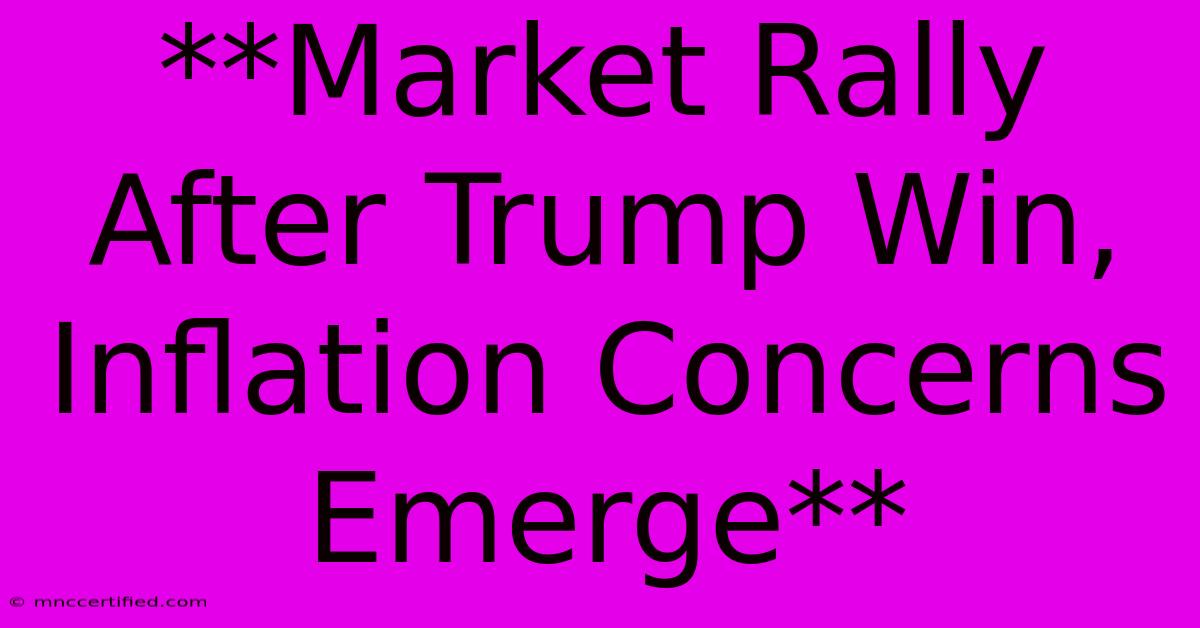**Market Rally After Trump Win, Inflation Concerns Emerge**

Table of Contents
Market Rally After Trump Win, Inflation Concerns Emerge
The stock market experienced a significant surge following Donald Trump's victory in the 2016 presidential election, buoyed by promises of tax cuts, deregulation, and increased infrastructure spending. However, this initial optimism was soon tempered by growing concerns about inflation, fueled by a combination of factors.
The Post-Election Rally: A Look Back
The Dow Jones Industrial Average, the S&P 500, and the Nasdaq Composite all registered substantial gains in the days following the election. This post-election market rally was largely attributed to investor confidence in Trump's economic policies, particularly his pledge to cut taxes for corporations and individuals.
The key factors driving the rally included:
- Tax Cuts: Trump promised significant corporate tax cuts, which were seen as a catalyst for economic growth and increased investment.
- Deregulation: His commitment to reducing government regulations was welcomed by businesses, who anticipated a more favorable environment for expansion.
- Infrastructure Spending: Trump's plans to invest heavily in infrastructure projects were expected to create jobs and stimulate economic activity.
Inflation Fears Begin to Rise
While the initial euphoria was palpable, anxieties about inflation began to surface as the Trump administration implemented its policies. These concerns stemmed from a confluence of factors, including:
- Fiscal Stimulus: The Trump administration's tax cuts and increased spending created a significant deficit, fueling fears that the government would be forced to print more money, potentially leading to inflation.
- Trade Wars: The Trump administration's imposition of tariffs on goods from China and other countries further exacerbated inflationary pressures, as businesses passed on increased costs to consumers.
- Supply Chain Disruptions: The global pandemic and subsequent lockdowns caused widespread supply chain disruptions, leading to shortages and higher prices.
- Strong Demand: The combination of government stimulus and pent-up demand following the pandemic led to a surge in consumer spending, driving up prices across various sectors.
The Balancing Act: Growth vs. Inflation
The market faced a delicate balancing act, navigating the potential for economic growth driven by Trump's policies against the risks of rising inflation. While the economy did experience some expansion, the inflationary pressures proved to be more persistent than anticipated.
The consequences of inflation included:
- Erosion of Purchasing Power: Inflation erodes the purchasing power of consumers, making it more expensive to buy goods and services.
- Interest Rate Hikes: The Federal Reserve responded to inflation by raising interest rates, making it more expensive for businesses to borrow money and potentially hindering economic growth.
- Market Volatility: The uncertainty surrounding inflation contributed to market volatility, as investors grappled with the potential impact on their investments.
Navigating the Future
The market's reaction to the Trump administration's policies highlighted the complex relationship between economic growth and inflation. While the initial rally reflected optimism about potential growth, the emergence of inflation concerns ultimately dampened investor enthusiasm.
Understanding the dynamics between these two forces remains crucial for investors, as navigating the future will likely require a careful assessment of both the potential for economic expansion and the risks associated with inflation.
This analysis aims to provide a historical context for understanding the complex interplay between market sentiment, economic policies, and inflation. It's important to note that the market is constantly evolving, and future outcomes may differ from past trends.

Thank you for visiting our website wich cover about **Market Rally After Trump Win, Inflation Concerns Emerge**. We hope the information provided has been useful to you. Feel free to contact us if you have any questions or need further assistance. See you next time and dont miss to bookmark.
Featured Posts
-
Rice Community Votes Democracy Celebrated
Nov 07, 2024
-
Can You Get Title Insurance After Closing
Nov 07, 2024
-
Gary Barlows Son Viral Height Story
Nov 07, 2024
-
2024 Election Results Connecticut Wednesday
Nov 07, 2024
-
Johnson Controls Earnings Strong Nasdaq Jumps 500
Nov 07, 2024